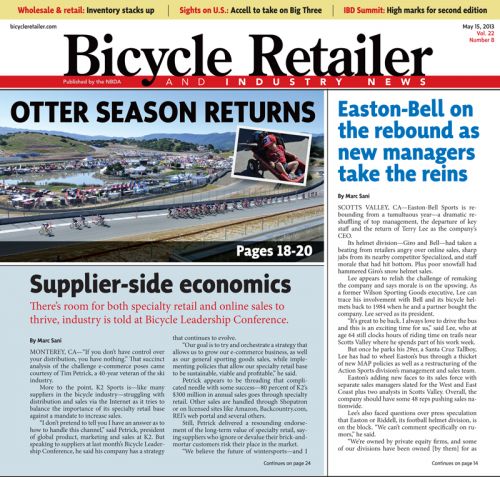SCOTTS VALLEY, CA (BRAIN) — Easton-Bell Sports is rebounding from a tumultuous year—a dramatic reshuffling of top management, the departure of key staff and the return of Terry Lee as the company’s CEO.
Its helmet division—Giro and Bell—had taken a beating from retailers angry over online sales, sharp jabs from its nearby competitor Specialized, and staff morale that had hit bottom. Plus poor snowfall had hammered Giro’s snow helmet sales.
Lee appears to relish the challenge of remaking the company and says morale is on the upswing. As a former Wilson Sporting Goods executive, Lee can trace his involvement with Bell and its bicycle helmets back to 1984 when he and a partner bought the company. Lee served as its president.
“It’s great to be back. I always love to drive the bus and this is an exciting time for us,” said Lee, who at age 64 still clocks hours of riding time on trails near Scotts Valley where he spends part of his work week.
But once he parks his 29er, a Santa Cruz Tallboy, Lee has had to wheel Easton’s bus through a thicket of new MAP policies as well as a restructuring of the Action Sports division’s management and sales team.
Easton’s adding new faces to its sales force with separate sales managers slated for the West and East Coast plus two analysts in Scotts Valley. Overall, the company should have some 48 reps pushing sales nationwide.
Lee’s also faced questions over press speculation that Easton or Riddell, its football helmet division, is on the block. “We can’t comment specifically on rumors,” he said.
“We’re owned by private equity firms, and some of our divisions have been owned [by them] for as long as 10 years. Someday they will sell; that’s what private equity firms do. But I haven’t seen many private equity firms sell on the tail end of a soft year.”
Lee quickly added that it’s just as likely Giro or Bell would acquire companies as be sold.
Nonetheless, Giro’s and Bell’s management team—Bernie Doering, Greg Shapleigh and Jessica Klodnicki—have been revamping the division’s MAP policy based on a Unilateral Price Grid. Essentially the policy—now in dealers’ hands—reaffirms dealers’ rights to set their own pricing. However, dealers who fall below a minimum price set by the grid could find themselves without products to sell—indefinitely. The company also implemented pricing policies for carry-over inventory.
More important for some, the company has stopped direct sales to Amazon, although dealers could apply to become authorized Amazon sellers.
In addition, all sales through eBay.com, Sears.com, Craigslist.com, BestBuy.com, Bizrate.com, Google.com, Nextag.com, Buy.com, Pricegrabber.com, Yahoo.com, Walmart.com and Overstock.com are banned. And dealers, who had sold products outside their territory, especially to international buyers, are prohibited from doing so.
Bell helmet sales through the mass market and sporting goods channels continue to rile specialty retailers. But as a multichannel and multi-brand company its strategy is to target different consumers with distinct products and price points.
Lee acknowledges that Easton-Bell Sports had to tackle issues raised by sales on the web. “I do agree it’s an issue. It needed to be addressed and it needed to be addressed aggressively. We’ve taken action and we will continue to take action to police our policies and monitor them going forward,” he said.
As for priorities, Lee said the company has to be viewed as “IBD focused” in terms of MAP policies, margins, price points and sales leadership. “We’re focused on all these points. That’s our foundation and our core,” he said.
But as Lee looks ahead he’s bullish on Easton-Bell and specialty retail. “It’s a fast-moving market for the industry and for retailers,” he said.
“I believe retailers need to stay focused and offer good product selection. There’s been a big change in social marketing and websites matter, best practices matter, POP matters, key price points matter. It’s a very competitive market and it’s best to stay on the leading edge and winning.”




